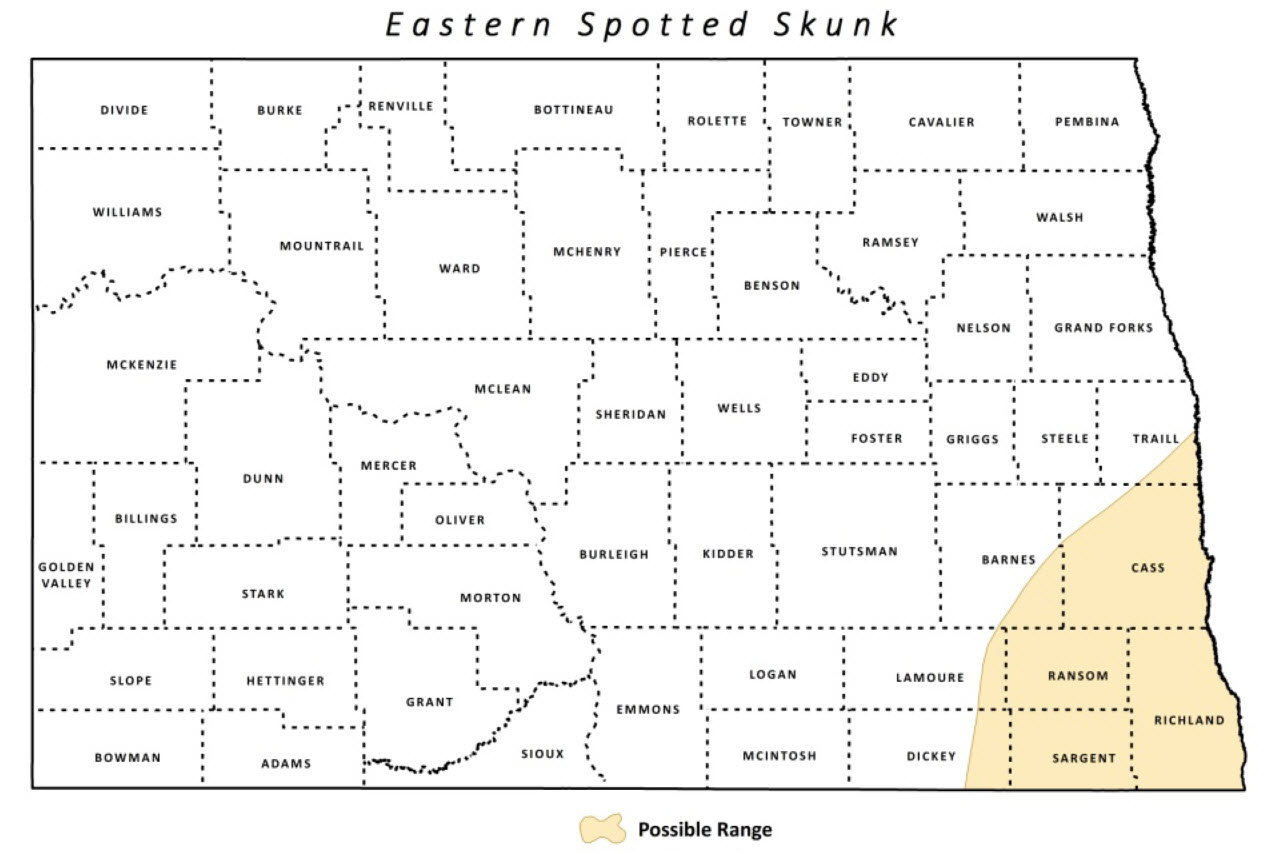
Eastern Spotted Skunk
| Scientific Name | Spilogale putorius |
|---|---|
| General Description | Roughly the size of a small house cat, it is distinguishable from the more common striped skunk by six white spots running the length of its back, and a small white spot between its eyes. It also has an all-black tail with a white tip. Nocturnal and highly secretive. |
| Status | Potential year-round resident. Has not been document recently in the state. |
| Abundance | Rare |
| Primary Habitat | Found in riparian areas and vegetated fence lines along agricultural fields. Den in dark, dry burrows dug themselves or by other mammals. May also den in haystacks, rock piles or abandoned buildings. |
| Federal Status | Currently under petition for protection under the threatened and endangered species act. |
| Reason for Designation | Little is known regarding the habitats of this secretive species. Riparian habitat it uses is threatened by agricultural practices and overgrazing. This species is likely on the edge of its range in North Dakota. |
Locations and Conditions of Key Habitat
Preferred Habitat
In prairie habitats this species can be found in wooded riparian areas or vegetation and fence rows along agricultural fields. Found hunting small mammals, reptiles, and amphibians at night in crop fields.
Key Areas and Conditions for Eastern Spotted Skunk in North Dakota
No specific focus areas have been identified. Was not documented in recent meso-carnivore surveys so its presence in North Dakota is unclear.
Problems Which May Affect this Species
Habitat
Loss of riparian areas is a major concern for Eastern Spotted Skunk. It uses these areas to hunt, and also dens in logs and brush piles.
Other Natural or Manmade Factors
In other parts of its range, automobile collisions and poisoning are known threats to this species.
Research and Survey Efforts
Current Research or Surveys
- Northeastern State University and Dickinson State University are currently studying “Fringe Mammals” in western North Dakota. This includes Eastern Spotted Skunk.
Previous Research or Surveys
- Frostburg State University conducted meso-carnivore surveys within the believed range of the Eastern Spotted Skunk.
Additional Research or Surveys Needed
• Determine presence of Eastern Spotted Skunk in the state. • Develop a protocol to monitor the Eastern Spotted Skunk in the state. • Develop research to define ecology, resource needs, and population dynamics of this species in the state if found to be present.
Management Recommendations
- • Protect rivers, streams, and riparian areas where possible (i.e. easements and/or acquisition). • Continue to use the Section 404 program to ensure affected rivers and riparian areas are mitigated to replace form and function. • Continue to work with other federal agencies (i.e. FAA and FHWA) not covered by Section 404 or Swampbuster to ensure affected rivers and riparian areas are mitigated to replace form and function. • Develop and promote incentive programs to restore riparian areas.
Monitoring Plans
No monitoring plan has been developed for this species.
2005-2015 Progress
The Eastern Spotted Skunk remains a Level III Species of Conservation Priority. Efforts to document the species in SWG T-12-R Evaluating the Distribution and Abundance of River Otters and Other Meso-carnivores in Eastern North Dakota Drainage: Applications of GIS, Genetic and Digital Technologies for Conservation Planning were unsuccessful. It has recently been petitioned for protection under the Endangered Species Act and North Dakota is considered within its range.

Note: A listing of works consulted when compiling the information on this page may be found in the 2015 State Wildlife Action Plan.
